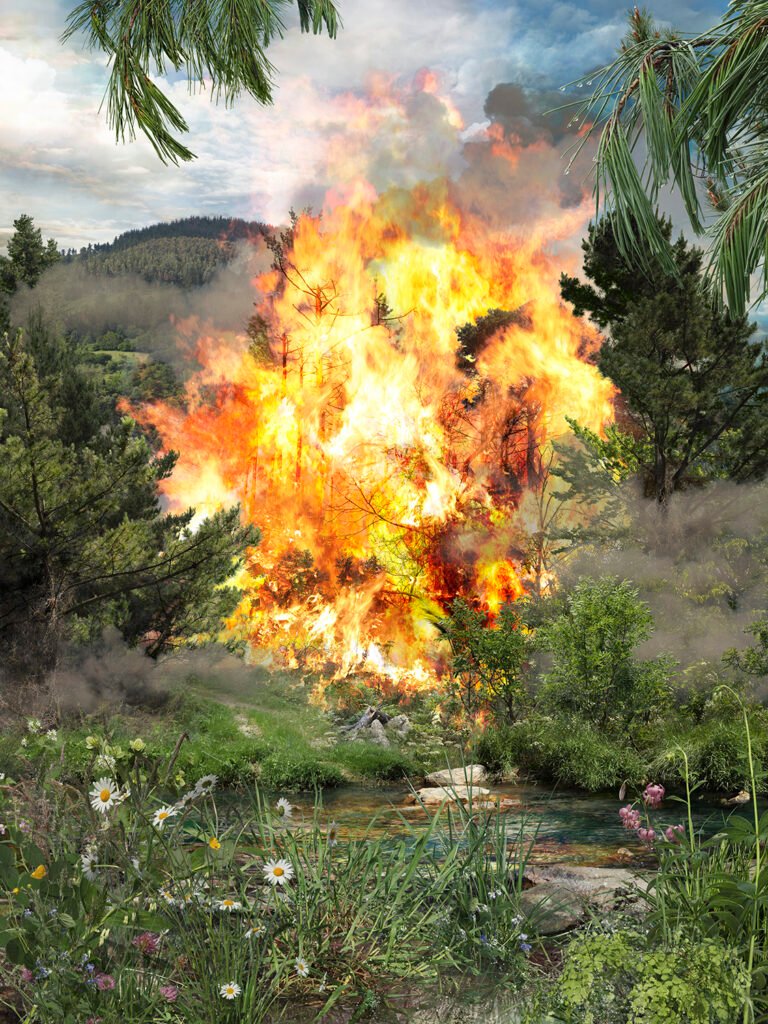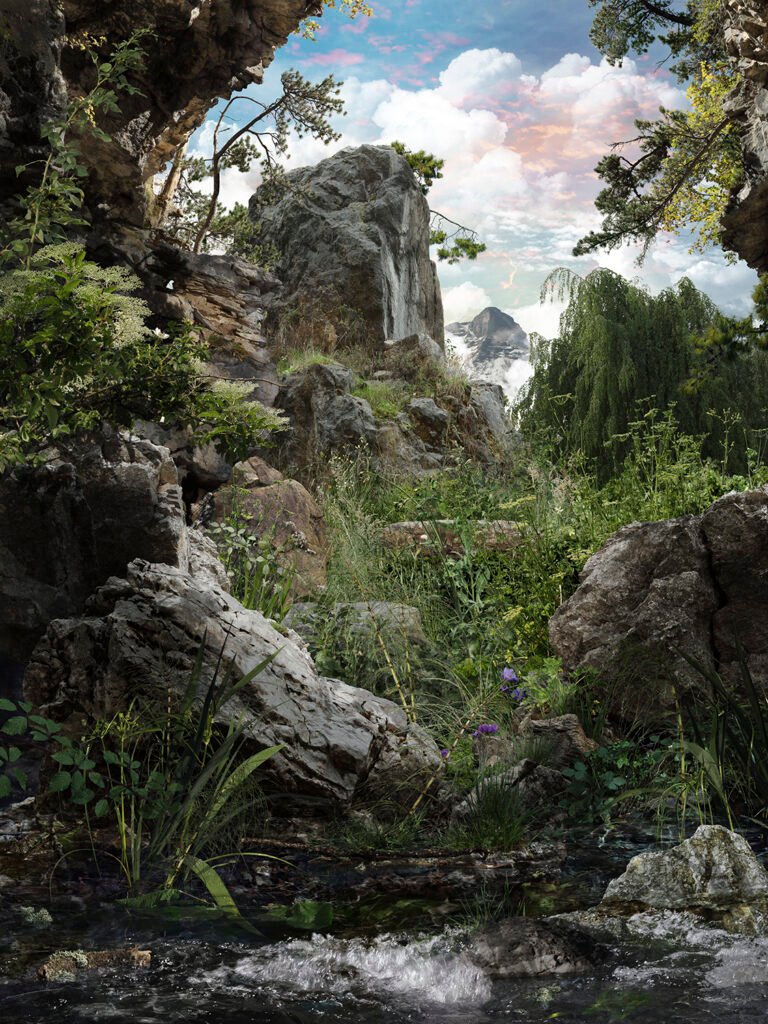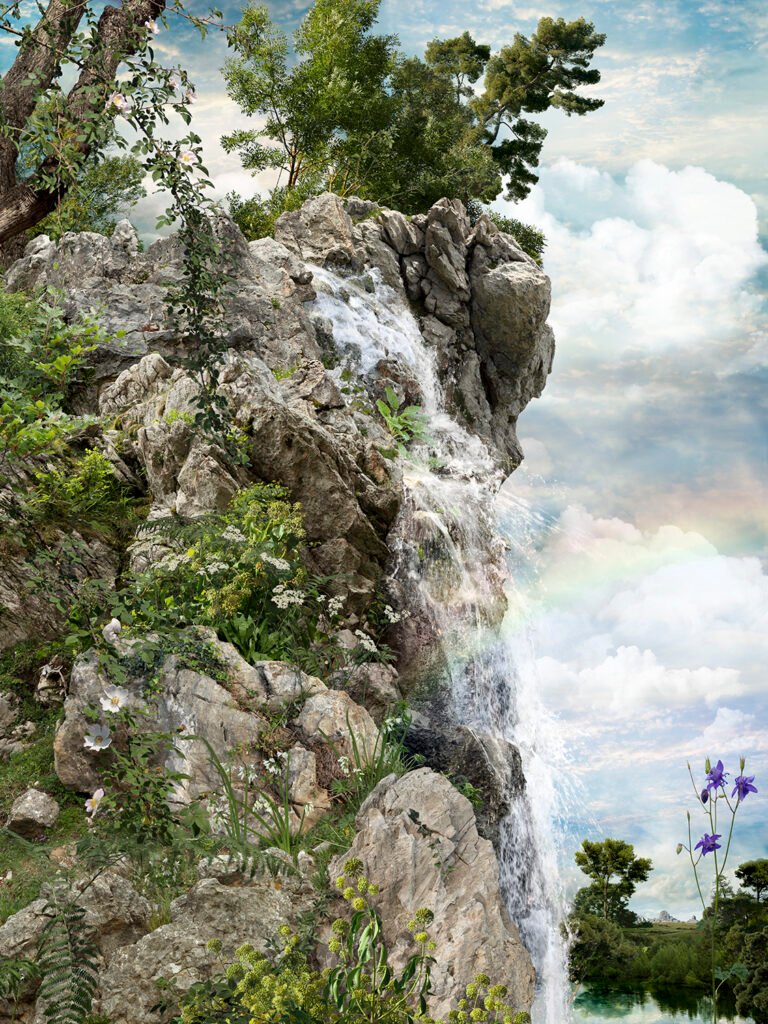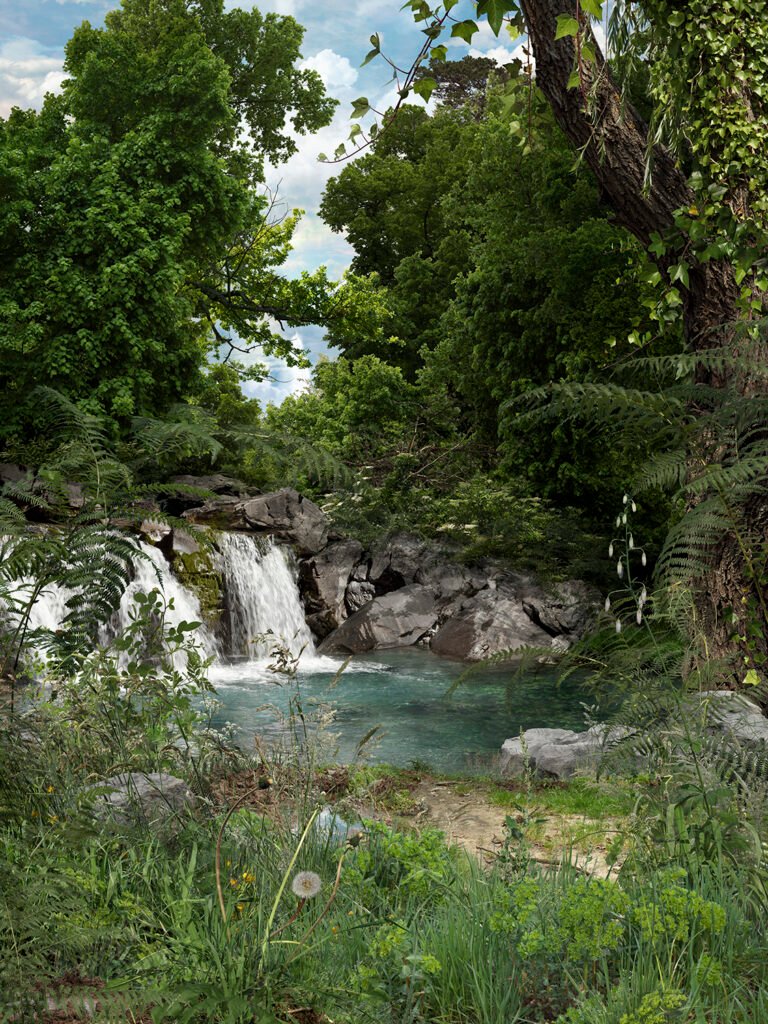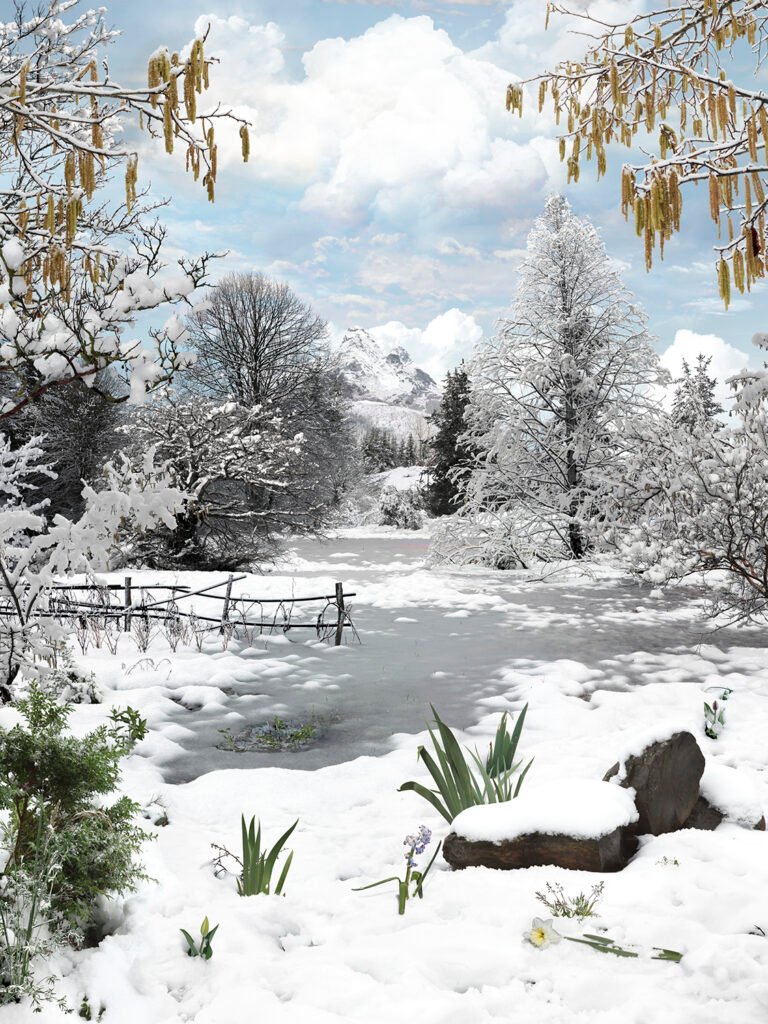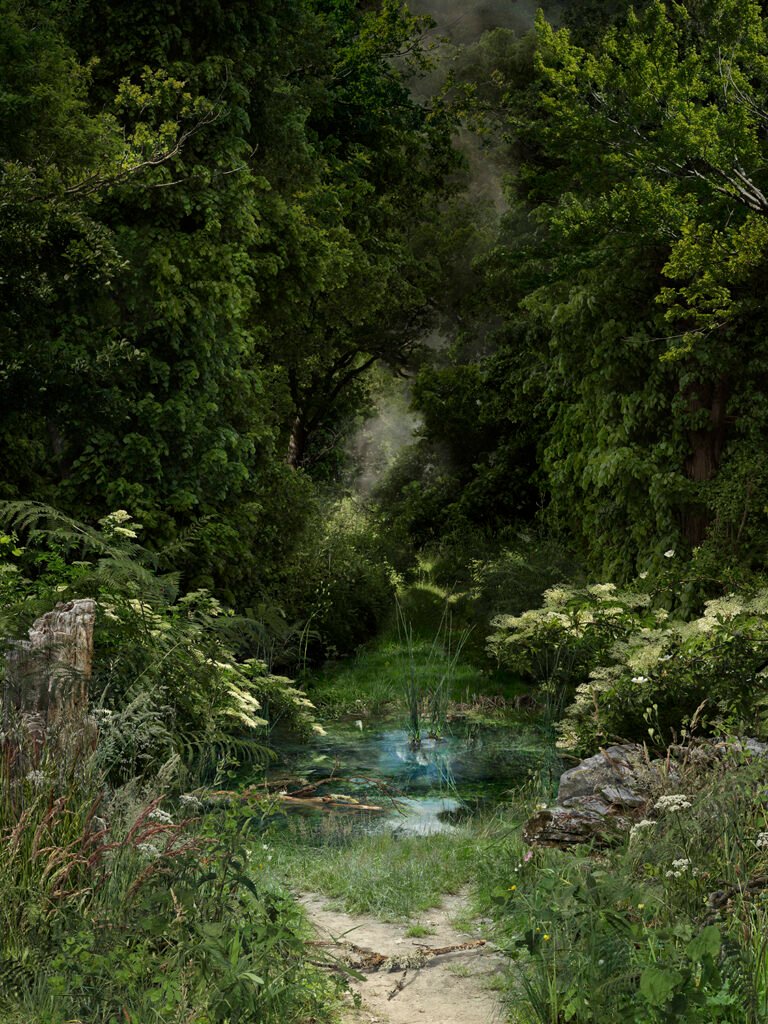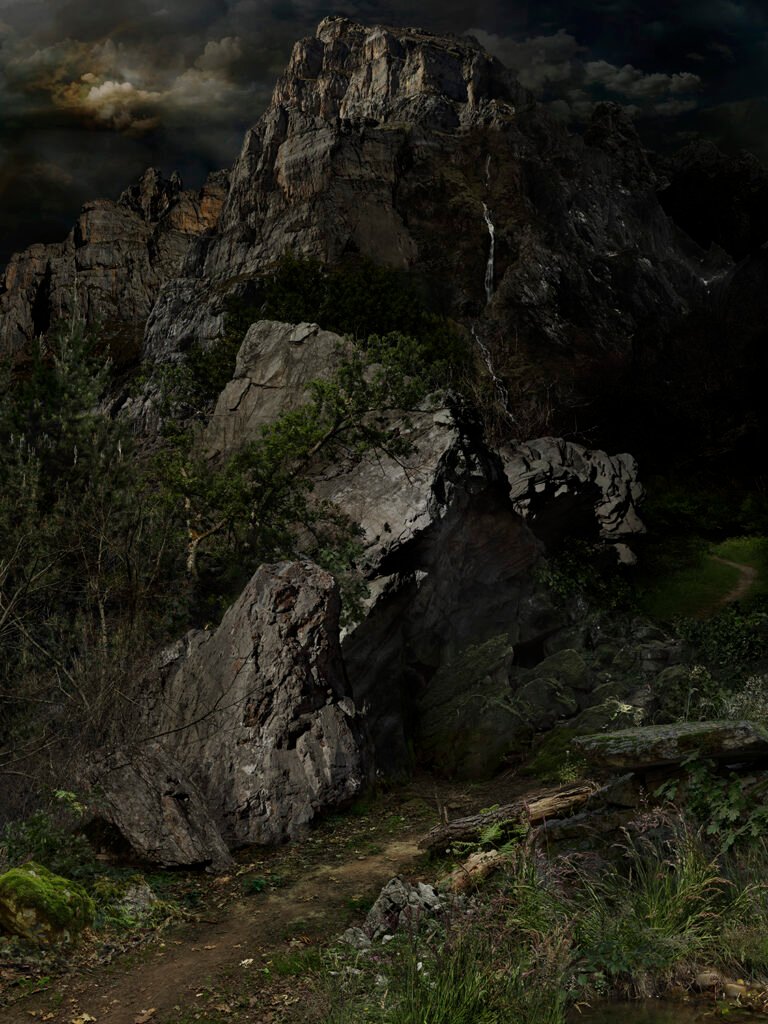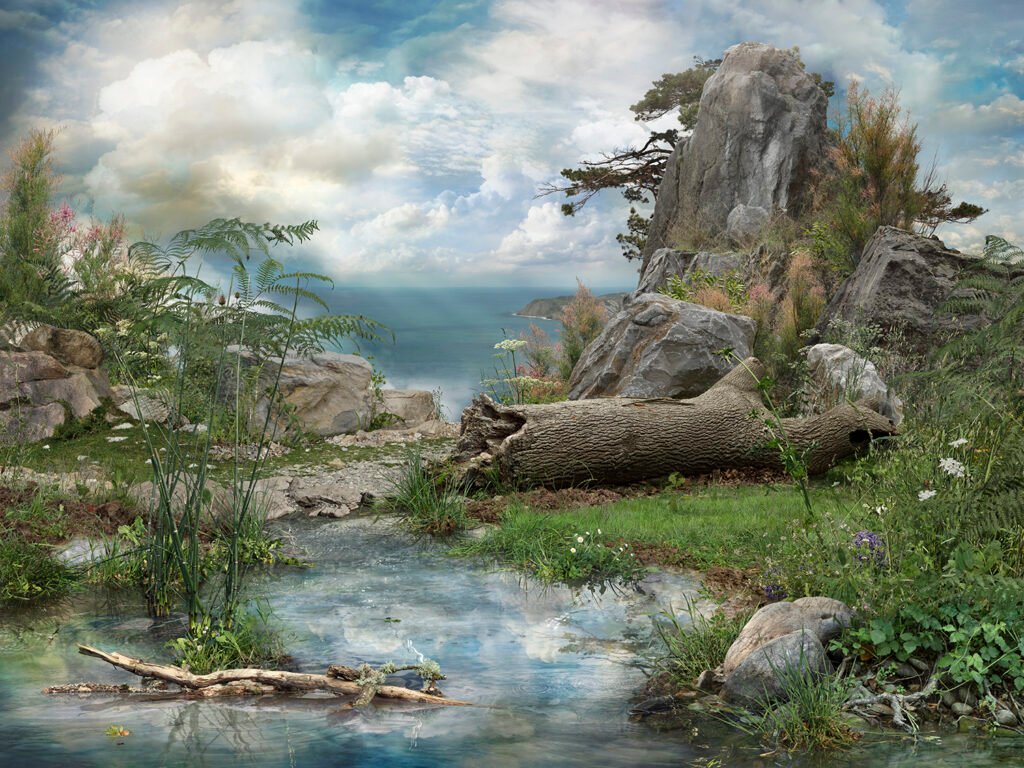The Parque natural series is composed of twelve photographs offering different views of a fictitious natural park. A path and a river run through each image, proposing a route through a succession of scenes: idealized landscapes constructed from stereotypes, pictorial references and visual inheritances with which our view of nature has been built throughout history. The methods used for the creation of these images allude to the era of photographic pictorialism in the 19th century, when photography, recently invented, sought its own languages and inevitably inherited the codes of painting. Each image is digitally composed from a library of photographs of elements of nature. This photographic archive is created from my immediate environment, as if it were a personal cartography, and is merged using blue-chroma backgrounds, methods typical of the special effects of cinema. Each photograph of Parque natural is the result of an imaginary that gathers different layers and levels of reading, intermingling the sensitive relationship with the environment, the personal look, historical projections on the landscape, the sacred, the mythological, the political and the analytical look of science.
The concept of national park appeared in the 19th century. A national park can be defined as an institutionalized space within nature, preserved in a supposedly original state, a sort of Eden tailored to the cultural concerns of an era. Here there is a parallel between the concept of monument and landscape. A monument builds a memory extolling certain values and is the writing of history from a certain point of view, an image that is the product of an ideology. There can be an effect of monumentalization of the landscape when it becomes a repository of these values, representing a lost paradise that connects with mythical origins. National parks, natural parks and protected areas are variations of the same concept, but they take into account the historical relationships with the environment, specific to each territory.
At this time, the United States set its sights on its vast expanses of land, which had already been portrayed by its landscape painters, the Hudson River School, influenced by European romanticism. Yellowstone is the first national park and the first territory not exposed to the speed with which the industrial revolution is modifying and exploiting natural environments. These approaches were quickly imported to Europe. For example, in France, the painters of the School of Barbizon, raised the need to protect the forests of Fontainebleau from systematic logging, while the mountainous massif of Picos de Europa became the first national park in Spain. The mountain becomes the main icon of the parks, the feeling of the sublime; the immensity of its scale turns it into an attractive image that, added to the revolution of transportation with the railroad, favors the tourism industry. The Grand Tour, previously destined for the European elite, becomes popular and the travel experience becomes more accessible.
In Parque natural 1, a path leads our gaze towards a distant mountain, a model made in the style of a theater or movie set, alluding to the iconic Matterhorn. In Parque natural 2, a swirling sky over the mountain evokes the fury of the gods of Olympus, the originators of Western mythological tales. Since the Renaissance, painting has staged the myths in natural locations, forests, rivers, etc. Therefore, throughout the Parque natural series I have also represented classical myths but using their botanical eponyms, the scientific names of plants named after divinities. Thus, the account of the taxonomic rationalism of the Enlightenment merges with the myth (e.g. Mercury–Mercurialis perennis).
As the geographer Denis Cosgrove points out, the invention of perspective implants a supremacy of the sense of sight in the Renaissance, as vision and knowledge are identified. Perspective establishes a rationalization and systematization of space; everything can be represented and delimited by means of coordinates. At the same time, the territorial uses of the feudal era gave way to an era of openness in terms of ownership and exploitation, in addition to the exploration and exploitation of new territories, such as the American continent by Europe. These changes proliferated the production of cartographies, territory delimitation maps and, above all, the rise of the pictorial genre of landscape. In Parque natural 7, Leonardo da Vinci’s guidelines are put into practice in reference to the aerial perspective, a variant in which geometry is replaced by the atmospheric recreation using color, the light and bluish tones denote the remoteness. In the image, the landscape literally extends into outer space, the moon being the vanishing point, but its image is brought into the foreground by its reflection in the water. This visual artifice, which will have its maximum expression in the Baroque, works in the image to represent Endimion’s dream. The myth tells that Selene, goddess of the moon, falls in love with the beautiful shepherd Endymion and that while he sleeps, the goddess accompanies him, reliving every night a dreamlike romance. In the photograph, the romance occurs when the moon, with its reflection in a pool of water, approaches the flower Endymion hispanicus, the eponymous plant of the mythological shepherd.
The visual character of the origin of natural parks refers us to the frame, to the window, something that inevitably makes us think of what is outside the frame, the out-of-field. We see that in the history of their creation they have been mostly colonized places, regions of empires, territories where the tabula rasa is applied, erasing the previous stories and systems of relations, a process where the tragic is implicit. In Parque natural 8, from the myth of the labors of Hercules, in which he must leave for the underworld, alludes to the imaginary of adventure, of the exotic, the desert island. The scene represents the return of Hercules from the underworld after the capture of the dog Cervero, returning from an exotic version of the Island of the Dead in Arnold Böcklin’s symbolist painting, where exuberant palm trees replace the funereal cypresses.
Every culture has developed and evolved to a greater or lesser extent thanks to the exploitation of natural resources, although it is since the industrial revolution that this exploitation has become more aggressive and global. A mountain, a river or a tree can be the vehicle to the sacred and transcendental, just as they can be raw material for production. The sadness of Ceres, goddess of agriculture, in the myth of Proserpina seems to be very representative of this era. Parque natural 6, set in a winter landscape, narrates in its Roman version the abduction of Proserpina. The desperation of Ceres to find her daughter Proserpina kidnapped by Hades in the underworld, paralyzes the cycle of nature causing an eternal winter. To stop the agony of the earth, Jupiter sends Mercury in search of Proserpina and it is at that moment when spring springs again. In the image, the mythological scene is represented by the aquatic species Proserpinaca palustris accompanied by the Mercurialis perennis.
Nature has been the nexus with the transcendental in multiple cultures. In particular, mysticism has used the landscape as a metaphorical and spiritual figure. Parque natural 9 refers to this projection on the landscape, with the mystical figure created by San Juan de la Cruz of the Dark night of the soul. In his Mount of perfection he proposes a journey towards the purification of the spirit, with a stop in a cave that invites to hermit retreat, a place for silence and emptying of the senses. The nocturnal landscape is a spiritual state sought in mysticism, an atmosphere that is represented in Spanish Baroque painting with its characteristic tenebrism.
In short, Parque natural proposes a walk through 12 landscapes exploring the mechanisms of construction of our gaze on nature but, above all, it tries to offer the simple sensory experience of a walk.
José Ramón Ais (Bilbao 1971) is a visual artist. His work explores the emotional links and ways in which stories, ideologies, desires and utopias are projected onto nature. He seeks to reflect upon and experiment with concepts related to the landscape, understood as both a construction and a representation.
His processes begin with the cultivation, observation and documentation of plants, in a hybrid territory somewhere between garden, studio and set. This practice combines photography and post-production imaging techniques, as well as active fieldwork and historical research.
Getxophoto is an image festival created and managed by Begihandi, that has been taking place in Getxo—Basque Country, Euskadi—since 2007. This festival is part of a cultural ecosystem with the aim of being more participatory, hybrid, committed and sustainable. This thematic Festival is conceived as a platform that addresses contemporary challenges through different proposals, from visual storytellers around the world, in an attempt to create spaces for reflection and establish a collective conversation. Getxophoto is characterized by the radical defense of public space (both physical and online). For this reason, most of its programme is composed of outdoor installations, highlighting, on the one hand, the link between the image and the environment and, on the other, generating a more horizontal and participatory relationship with the public.
This year, after PAUSE and PLAY, the festival will take the theme: REC. The abbreviation for Record, which usually appears as a red circle on our screens, refers to a register, to memory, to the story of the past, and to images as a witness to reality. The relationship between image and record is a central debate in visual studies, one that has been addressed by the great names of the theory of photography such as Walter Benjamin, Susan Sontag and Georges Didi-Huberman. But what is left of this debate today in relation to contemporary technologies? What is the difference between accumulating archives and telling a story? What is the future of the image—and of memory constructed through visual recording—in a world of extreme, immaterial, manipulable and seemingly infinite REC?
María Ptqk is the curator of GETXOPHOTO 2025.
